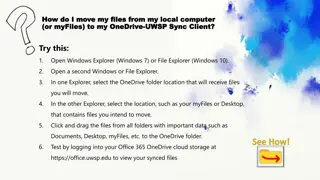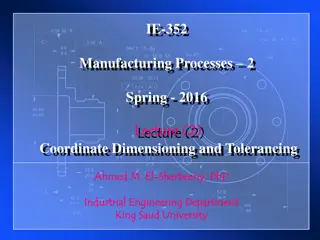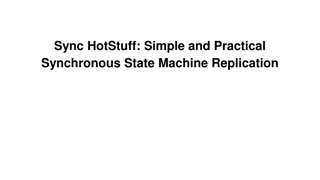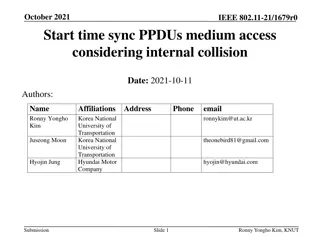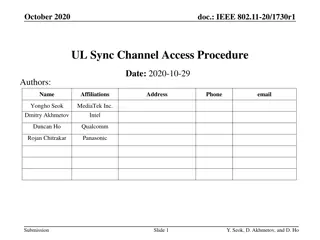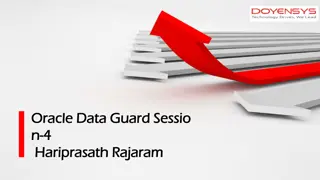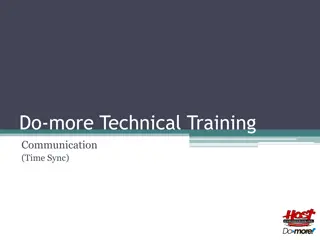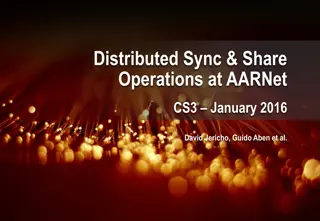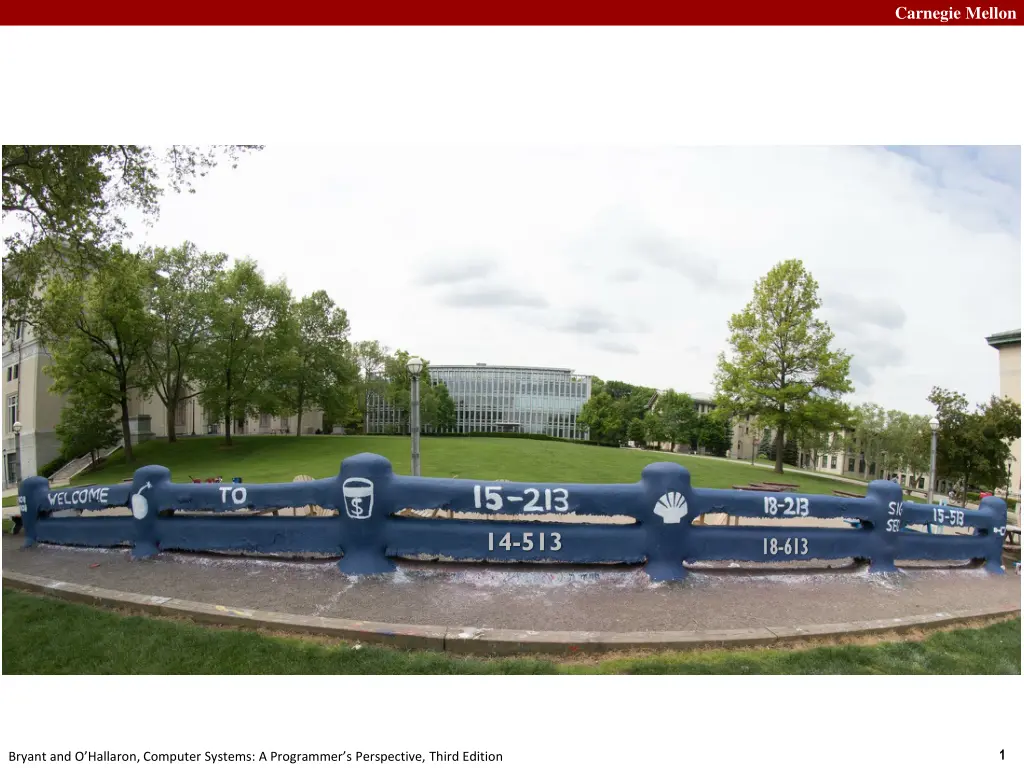
Understanding Carnegie Mellon Computer Systems: A Programmer's Perspective
Delve into the realm of computer systems at Carnegie Mellon University with insights on synchronization, process contexts, threads, and more from the perspective of programmers. Explore key topics and announcements for a comprehensive understanding of computer systems and processes.
Download Presentation

Please find below an Image/Link to download the presentation.
The content on the website is provided AS IS for your information and personal use only. It may not be sold, licensed, or shared on other websites without obtaining consent from the author. If you encounter any issues during the download, it is possible that the publisher has removed the file from their server.
You are allowed to download the files provided on this website for personal or commercial use, subject to the condition that they are used lawfully. All files are the property of their respective owners.
The content on the website is provided AS IS for your information and personal use only. It may not be sold, licensed, or shared on other websites without obtaining consent from the author.
E N D
Presentation Transcript
Carnegie Mellon 14-513 18 18- -613 613 1 Bryant and O Hallaron, Computer Systems: A Programmer s Perspective, Third Edition
Carnegie Mellon Synchronization: Basics 15-213/18-213/14-513/15-513/18-613: Introduction to Computer Systems 25th Lecture, December 1, 2020 2 Bryant and O Hallaron, Computer Systems: A Programmer s Perspective, Third Edition
Carnegie Mellon Announcements Final Exam will be Thu, Dec. 17 Three hours. 3 time slots: 8:30 am ET, 1 pm ET, 5:30 pm ET See Piazza post for form to indicate which slots work for you We will assign you a slot Lab 7a (proxy-ckpt) Due Thu, Dec. 3, 11:59pm ET Lab 7b (proxy-final) Due Thu, Dec 10, 11:59pm ET Then: OMG end of semester! 3 Bryant and O Hallaron, Computer Systems: A Programmer s Perspective, Third Edition
Carnegie Mellon Today Threads review Sharing CSAPP 12.4 CSAPP 12.5 CSAPP 12.5 CSAPP 12.5 Mutual exclusion Semaphores Producer-Consumer Synchronization 4 Bryant and O Hallaron, Computer Systems: A Programmer s Perspective, Third Edition
Carnegie Mellon Traditional View of a Process Process = process context + code, data, and stack Process context Code, data, and stack Stack Program context: Data registers Condition codes Stack pointer (SP) Program counter (PC) SP Shared libraries brk Run-time heap Read/write data Read-only code/data Kernel context: VM structures Descriptor table brk pointer PC 0 5 Bryant and O Hallaron, Computer Systems: A Programmer s Perspective, Third Edition
Carnegie Mellon Alternate View of a Process Process = thread + code, data, and kernel context Thread (main thread) Code, data, and kernel context Shared libraries Stack brk SP Run-time heap Read/write data Read-only code/data Thread context: Data registers Condition codes Stack pointer (SP) Program counter (PC) PC 0 Kernel context: VM structures Descriptor table brk pointer 6 Bryant and O Hallaron, Computer Systems: A Programmer s Perspective, Third Edition
Carnegie Mellon A Process With Multiple Threads Multiple threads can be associated with a process Each thread has its own logical control flow Each thread shares the same code, data, and kernel context Each thread has its own stack for local variables but not protected from other threads Each thread has its own thread id (TID) Thread 1 (main thread) Shared code and data Thread 2 (peer thread) shared libraries stack 1 stack 2 run-time heap read/write data read-only code/data Thread 1 context: Data registers Condition codes SP1 PC1 Thread 2 context: Data registers Condition codes SP2 PC2 0 Kernel context: VM structures Descriptor table brk pointer 7 Bryant and O Hallaron, Computer Systems: A Programmer s Perspective, Third Edition
Carnegie Mellon Today Threads review Sharing Mutual exclusion Semaphores Producer-Consumer Synchronization 8 Bryant and O Hallaron, Computer Systems: A Programmer s Perspective, Third Edition
Carnegie Mellon Shared Variables in Threaded C Programs Question: Which variables in a threaded C program are shared? The answer is not as simple as global variables are shared and stack variables are private Def: A variable x is shared if and only if multiple threads reference some instance of x. Requires answers to the following questions: What is the memory model for threads? How are instances of variables mapped to memory? How many threads might reference each of these instances? 9 Bryant and O Hallaron, Computer Systems: A Programmer s Perspective, Third Edition
Carnegie Mellon Threads Memory Model: Conceptual Multiple threads run within the context of a single process Each thread has its own separate thread context Thread ID, stack, stack pointer, PC, condition codes, and GP registers All threads share the remaining process context Code, data, heap, and shared library segments of the process virtual address space Open files and installed handlers Thread 1 (private) Thread 2 (private) Shared code and data stack 1 stack 2 shared libraries Thread 1 context: Data registers Condition codes SP1 PC1 Thread 2 context: Data registers Condition codes SP2 PC2 run-time heap read/write data read-only code/data 10 Bryant and O Hallaron, Computer Systems: A Programmer s Perspective, Third Edition
Carnegie Mellon Threads Memory Model: Actual Separation of data is not strictly enforced: Register values are truly separate and protected, but Any thread can read and write the stack of any other thread Virtual Address Space stack 1 stack 2 Shared code and data Thread 1 (private) Thread 2 (private) shared libraries Thread 1 context: Data registers Condition codes SP1 PC1 Thread 2 context: Data registers Condition codes SP2 PC2 run-time heap read/write data read-only code/data The mismatch between the conceptual and operation model is a source of confusion and errors 11 Bryant and O Hallaron, Computer Systems: A Programmer s Perspective, Third Edition
Carnegie Mellon Example Program to Illustrate Sharing char **ptr; /* global var */ void *thread(void *vargp) { long myid = (long)vargp; static int cnt = 0; int main(int argc, char *argv[]) { long i; pthread_t tid; char *msgs[2] = { "Hello from foo", "Hello from bar" }; printf("[%ld]: %s (cnt=%d)\n", myid, ptr[myid], ++cnt); return NULL; } Peer threads reference main thread s stack indirectly through global ptr variable ptr = msgs; for (i = 0; i < 2; i++) Pthread_create(&tid, NULL, thread, (void *)i); Pthread_exit(NULL); A common, but inelegant way to pass a single argument to a thread routine } sharing.c 12 Bryant and O Hallaron, Computer Systems: A Programmer s Perspective, Third Edition
Carnegie Mellon Mapping Variable Instances to Memory Global variables Def: Variable declared outside of a function Virtual memory contains exactly one instance of any global variable Local variables Def: Variable declared inside function without static attribute Each thread stack contains one instance of each local variable Local static variables Def: Variable declared inside function with the static attribute Virtual memory contains exactly one instance of any local static variable. 13 Bryant and O Hallaron, Computer Systems: A Programmer s Perspective, Third Edition
Carnegie Mellon Mapping Variable Instances to Memory Notation: instance of msgs in main Global var: 1 instance (ptr [data]) Local vars: 1 instance (i.m, msgs.m) char **ptr; /* global var */ Local var: 2 instances ( myid.p0 [peer thread 0 s stack], myid.p1 [peer thread 1 s stack] ) int main(int main, char *argv[]) { long i; pthread_t tid; char *msgs[2] = { "Hello from foo", "Hello from bar" }; void *thread(void *vargp) { long myid = (long)vargp; static int cnt = 0; ptr = msgs; for (i = 0; i < 2; i++) Pthread_create(&tid, NULL, thread, (void *)i); Pthread_exit(NULL); printf("[%ld]: %s (cnt=%d)\n", myid, ptr[myid], ++cnt); return NULL; } Local static var: 1 instance (cnt [data]) } sharing.c 14 Bryant and O Hallaron, Computer Systems: A Programmer s Perspective, Third Edition
Carnegie Mellon Shared Variable Analysis Which variables are shared? Variable Referenced by instance main thread? Referenced by peer thread 0? Referenced by peer thread 1? yes no yes yes no no yes yes no yes yes no yes yes no yes no yes ptr cnt i.m msgs.m myid.p0 myid.p1 char **ptr; /* global var */ int main(int main, char *argv[]) { long i; pthread_t tid; char *msgs[2] = {"Hello from foo", "Hello from bar" }; ptr = msgs; for (i = 0; i < 2; i++) void *thread(void *vargp) { long myid = (long)vargp; static int cnt = 0; Answer: A variable x is shared iff multiple threads reference at least one instance of x. Thus: ptr, cnt, and msgs are shared i and myid are not shared Pthread_create(&tid, NULL, thread,(void *)i); Pthread_exit(NULL);} printf("[%ld]: %s (cnt=%d)\n", myid, ptr[myid], ++cnt); return NULL; } 15 Bryant and O Hallaron, Computer Systems: A Programmer s Perspective, Third Edition
Carnegie Mellon Shared Variable Analysis Which variables are shared? Variable Referenced by instance main thread? Referenced by peer thread 0? Referenced by peer thread 1? yes no yes yes no no yes yes no yes yes no yes yes no yes no yes ptr cnt i.m msgs.m myid.p0 myid.p1 Answer: A variable x is shared iff multiple threads reference at least one instance of x. Thus: ptr, cnt, and msgs are shared i and myid are not shared 16 Bryant and O Hallaron, Computer Systems: A Programmer s Perspective, Third Edition
Carnegie Mellon Synchronizing Threads Shared variables are handy... but introduce the possibility of nasty synchronization errors. 17 Bryant and O Hallaron, Computer Systems: A Programmer s Perspective, Third Edition
Carnegie Mellon badcnt.c: Improper Synchronization /* Thread routine */ void *thread(void *vargp) { long j, niters = *((long *)vargp); for (j = 0; j < niters; j++) cnt++; /* Global shared variable */ volatile long cnt = 0; /* Counter */ int main(int argc, char **argv) { long niters; pthread_t tid1, tid2; niters = atoi(argv[1]); Pthread_create(&tid1, NULL, thread, &niters); Pthread_create(&tid2, NULL, thread, &niters); Pthread_join(tid1, NULL); Pthread_join(tid2, NULL); return NULL; } linux> ./badcnt 10000 OK cnt=20000 linux> ./badcnt 10000 BOOM! cnt=13051 linux> /* Check result */ if (cnt != (2 * niters)) printf("BOOM! cnt=%ld\n", cnt); else printf("OK cnt=%ld\n", cnt); exit(0); } cnt should equal 20,000. badcnt.c What went wrong? 18 Bryant and O Hallaron, Computer Systems: A Programmer s Perspective, Third Edition
Carnegie Mellon Assembly Code for Counter Loop C code for counter loop in thread i for (j = 0; j < niters; j++) cnt++; Asm code for thread i movq (%rdi), %rcx testq %rcx,%rcx jle .L2 movl $0, %eax .L3: movq cnt(%rip),%rdx addq $1, %rdx movq %rdx, cnt(%rip) addq $1, %rax cmpq %rcx, %rax jne .L3 .L2: Hi: Head Li : Load cnt Ui : Update cnt Si : Store cnt Ti : Tail 19 Bryant and O Hallaron, Computer Systems: A Programmer s Perspective, Third Edition
Carnegie Mellon Concurrent Execution Key idea: In general, any sequentially consistent* interleaving is possible, but some give an unexpected result! Ii denotes that thread i executes instruction I %rdxi is the content of %rdx in thread i s context i (thread) instri %rdx1 %rdx2 cnt 1 1 1 1 2 2 2 2 2 1 H1 L1 U1 S1 H2 L2 U2 S2 T2 T1 - 0 1 1 - - - - - 1 - - - - - 1 2 2 2 - 0 0 0 1 1 1 1 2 2 2 OK *For now. In reality, on x86 even non-sequentially consistent interleavings are possible 20 Bryant and O Hallaron, Computer Systems: A Programmer s Perspective, Third Edition
Carnegie Mellon Concurrent Execution Key idea: In general, any sequentially consistent interleaving is possible, but some give an unexpected result! Ii denotes that thread i executes instruction I %rdxi is the content of %rdx in thread i s context i (thread) instri %rdx1 %rdx2 cnt 1 1 1 1 2 2 2 2 2 1 H1 L1 U1 S1 H2 L2 U2 S2 T2 T1 - 0 1 1 - - - - - 1 - - - - - 1 2 2 2 - 0 0 0 1 1 1 1 2 2 2 Thread 1 critical section Thread 2 critical section OK 21 Bryant and O Hallaron, Computer Systems: A Programmer s Perspective, Third Edition
Carnegie Mellon Concurrent Execution (cont) Incorrect ordering: two threads increment the counter, but the result is 1 instead of 2 i (thread) instri %rdx1 %rdx2 cnt 1 1 1 2 2 1 1 2 2 2 H1 L1 U1 H2 L2 S1 T1 U2 S2 T2 - 0 1 - - 1 1 - - - - - - - 0 - - 1 1 1 0 0 0 0 0 1 1 1 1 1 Oops! 22 Bryant and O Hallaron, Computer Systems: A Programmer s Perspective, Third Edition
Carnegie Mellon Concurrent Execution (cont) How about this ordering? i (thread) instri %rdx1 %rdx2 cnt 0 1 1 2 2 2 2 1 1 1 2 H1 L1 H2 L2 U2 S2 U1 S1 T1 T2 0 0 1 1 1 1 1 1 1 Oops! 1 We can analyze the behavior using a progress graph 23 Bryant and O Hallaron, Computer Systems: A Programmer s Perspective, Third Edition
Carnegie Mellon Progress Graphs A progress graph depicts the discrete execution state space of concurrent threads. Thread 2 T2 (L1, S2) Each axis corresponds to the sequential order of instructions in a thread. S2 U2 Each point corresponds to a possible execution state (Inst1, Inst2). L2 E.g., (L1, S2) denotes state where thread 1 has completed L1 and thread 2 has completed S2. H2 Thread 1 H1 L1 U1 S1 T1 24 Bryant and O Hallaron, Computer Systems: A Programmer s Perspective, Third Edition
Carnegie Mellon Trajectories in Progress Graphs Thread 2 A trajectory is a sequence of legal state transitions that describes one possible concurrent execution of the threads. T2 S2 Example: H1, L1, U1, H2, L2, S1, T1, U2, S2, T2 U2 L2 H2 Thread 1 H1 L1 U1 S1 T1 25 Bryant and O Hallaron, Computer Systems: A Programmer s Perspective, Third Edition
Carnegie Mellon Trajectories in Progress Graphs Thread 2 A trajectory is a sequence of legal state transitions that describes one possible concurrent execution of the threads. T2 S2 Example: H1, L1, U1, H2, L2, S1, T1, U2, S2, T2 U2 L2 H2 Thread 1 H1 L1 U1 S1 T1 26 Bryant and O Hallaron, Computer Systems: A Programmer s Perspective, Third Edition
Carnegie Mellon Critical Sections and Unsafe Regions Thread 2 L, U, and S form a critical section with respect to the shared variable cnt T2 Instructions in critical sections (wrt some shared variable) should not be interleaved S2 critical section wrt cnt U2 Unsafe region Sets of states where such interleaving occurs form unsafe regions L2 H2 Thread 1 H1 L1 U1 S1 T1 critical section wrt cnt 27 Bryant and O Hallaron, Computer Systems: A Programmer s Perspective, Third Edition
Carnegie Mellon Critical Sections and Unsafe Regions Thread 2 safe Def: A trajectory is safe iff it does not enter any unsafe region T2 Claim: A trajectory is correct (wrt cnt) iff it is safe S2 critical section wrt cnt U2 Unsafe region unsafe L2 H2 Thread 1 H1 L1 U1 S1 T1 critical section wrt cnt 28 Bryant and O Hallaron, Computer Systems: A Programmer s Perspective, Third Edition
Carnegie Mellon badcnt.c: Improper Synchronization /* Thread routine */ void *thread(void *vargp) { long j, niters = *((long *)vargp); for (j = 0; j < niters; j++) cnt++; /* Global shared variable */ volatile long cnt = 0; /* Counter */ int main(int argc, char **argv) { long niters; pthread_t tid1, tid2; niters = atoi(argv[1]); Pthread_create(&tid1, NULL, thread, &niters); Pthread_create(&tid2, NULL, thread, &niters); Pthread_join(tid1, NULL); Pthread_join(tid2, NULL); return NULL; } Variable main thread1 thread2 cnt yes* yes yes niters.m yes yes yes /* Check result */ if (cnt != (2 * niters)) printf("BOOM! cnt=%ld\n", cnt); else printf("OK cnt=%ld\n", cnt); exit(0); } tid1.m yes no no j.1 no yes no j.2 no no yes niters.1 no yes no badcnt.c niters.2 no no yes 29 Bryant and O Hallaron, Computer Systems: A Programmer s Perspective, Third Edition
Carnegie Mellon Quiz Time! Check out: https://canvas.cmu.edu/courses/17808 30 Bryant and O Hallaron, Computer Systems: A Programmer s Perspective, Third Edition
Carnegie Mellon Today Threads review Sharing Mutual exclusion Semaphores Producer-Consumer Synchronization 31 Bryant and O Hallaron, Computer Systems: A Programmer s Perspective, Third Edition
Carnegie Mellon Enforcing Mutual Exclusion Question: How can we guarantee a safe trajectory? Answer: We must synchronize the execution of the threads so that they can never have an unsafe trajectory. i.e., need to guarantee mutually exclusive access for each critical section. Classic solution: Mutex (pthreads) Semaphores (Edsger Dijkstra) Other approaches (out of our scope) Condition variables (pthreads) Monitors (Java) 32 Bryant and O Hallaron, Computer Systems: A Programmer s Perspective, Third Edition
Carnegie Mellon MUTual EXclusion (mutex) Mutex: boolean synchronization variable enum {locked = 0, unlocked = 1} lock(m) If the mutex is currently not locked, lock it and return Otherwise, wait (spinning, yielding, etc) and retry unlock(m) Update the mutex state to unlocked 33 Bryant and O Hallaron, Computer Systems: A Programmer s Perspective, Third Edition
Carnegie Mellon MUTual EXclusion (mutex) Mutex: boolean synchronization variable * Swap(*a, b) [t = *a; *a = b; return t;] // [] atomic by the magic of hardware / OS Lock(m): while (swap(&m->state, locked) == locked) ; Unlock(m): m->state = unlocked; *For now. In reality, many other implementations and design choices (c.f., 15-410, 418, etc). 34 Bryant and O Hallaron, Computer Systems: A Programmer s Perspective, Third Edition
Carnegie Mellon badcnt.c: Improper Synchronization /* Thread routine */ void *thread(void *vargp) { long j, niters = *((long *)vargp); /* Global shared variable */ volatile long cnt = 0; /* Counter */ int main(int argc, char **argv) { long niters; pthread_t tid1, tid2; for (j = 0; j < niters; j++) cnt++; niters = atoi(argv[1]); Pthread_create(&tid1, NULL, thread, &niters); Pthread_create(&tid2, NULL, thread, &niters); Pthread_join(tid1, NULL); Pthread_join(tid2, NULL); return NULL; } /* Check result */ if (cnt != (2 * niters)) printf("BOOM! cnt=%ld\n", cnt); else printf("OK cnt=%ld\n", cnt); exit(0); } How can we fix this using synchronization? badcnt.c 35 Bryant and O Hallaron, Computer Systems: A Programmer s Perspective, Third Edition
Carnegie Mellon goodmcnt.c: Mutex Synchronization Define and initialize a mutex for the shared variable cnt: volatile long cnt = 0; /* Counter */ pthread_mutex_t mutex; pthread_mutex_init(&mutex, NULL); // No special attributes Surround critical section with lock and unlock: for (i = 0; i < niters; i++) { pthread_mutex_lock(&mutex); cnt++; pthread_mutex_unlock(&mutex); } Function Time (ms) niters = 106 linux> ./goodmcnt 10000 OK cnt=20000 linux> ./goodmcnt 10000 OK cnt=20000 linux> goodmcnt 214.0 goodcnt.c badcnt 12.0 Bryant and O Hallaron, Computer Systems: A Programmer s Perspective, Third Edition Slowdown 1.0 17.8 36
Carnegie Mellon Why Mutexes Work Thread 2 Provide mutually exclusive access to shared variable by surrounding critical section with lock and unlock operations T2 un(m) S2 Unsafe region U2 L2 -1 lo(m) 0 H2 1 0 0 0 Thread 1 H1 lo(m) L1 U1 S1 un(m) T1 Initially Bryant and O Hallaron, Computer Systems: A Programmer s Perspective, Third Edition m = 1 37
Carnegie Mellon Why Mutexes Work Thread 2 Provide mutually exclusive access to shared variable by surrounding critical section with lock and unlock operations T2 un(m) Mutex invariant creates a forbidden region that encloses unsafe region and that cannot be entered by any trajectory. S2 Unsafe region U2 L2 -1 lo(m) 0 H2 1 0 0 0 Thread 1 H1 lo(m) L1 U1 S1 un(m) T1 Initially Bryant and O Hallaron, Computer Systems: A Programmer s Perspective, Third Edition m = 1 38
Carnegie Mellon Why Mutexes Work Thread 2 Provide mutually exclusive access to shared variable by surrounding critical section with lock and unlock operations T2 un(m) Mutex invariant creates a forbidden region that encloses unsafe region and that cannot be entered by any trajectory. S2 Unsafe region U2 L2 0 lo(m) 0 1 0 H2 1 0 0 0 Thread 1 H1 lo(m) L1 U1 S1 un(m) T1 Initially Bryant and O Hallaron, Computer Systems: A Programmer s Perspective, Third Edition m = 1 39
Carnegie Mellon Why Mutexes Work Thread 2 Provide mutually exclusive access to shared variable by surrounding critical section with lock and unlock operations 1 1 0 0 0 0 1 1 T2 1 1 0 0 0 0 1 1 un(m) Forbidden region 0 0 0 0 -1 -1 -1 -1 Mutex invariant creates a forbidden region that encloses unsafe region and that cannot be entered by any trajectory. S2 0 0 0 0 -1 -1 -1 -1 Unsafe region U2 0 0 0 0 -1 -1 -1 -1 L2 -1 -1 -1 -1 0 0 0 0 lo(m) 1 1 0 0 0 0 1 1 H2 1 1 0 0 0 0 1 1 Thread 1 H1 lo(m) L1 U1 S1 un(m) T1 Initially m = 1 40 Bryant and O Hallaron, Computer Systems: A Programmer s Perspective, Third Edition
Carnegie Mellon Today Threads review Sharing Mutual exclusion Semaphores Producer-Consumer Synchronization 46 Bryant and O Hallaron, Computer Systems: A Programmer s Perspective, Third Edition
Carnegie Mellon Semaphores Semaphore: non-negative global integer synchronization variable. Manipulated by P and V operations. P(s) If s is nonzero, then decrement s by 1 and return immediately. Test and decrement operations occur atomically (indivisibly) If s is zero, then suspend thread until s becomes nonzero and the thread is restarted by a V operation. After restarting, the P operation decrements s and returns control to the caller. V(s): Increment s by 1. Increment operation occurs atomically If there are any threads blocked in a P operation waiting for s to become non- zero, then restart exactly one of those threads, which then completes its P operation by decrementing s. Semaphore invariant: (s >= 0) 47 Bryant and O Hallaron, Computer Systems: A Programmer s Perspective, Third Edition
Carnegie Mellon Semaphores Semaphore: non-negative global integer synchronization variable Manipulated by P and V operations: P(s): [ while (s == 0) wait(); s--; ] Dutch for Proberen (test) V(s): [ s++; ] Dutch for Verhogen (increment) OS kernel guarantees that operations between brackets [ ] are executed indivisibly Only one P or V operation at a time can modify s. When while loop in P terminates, only that P can decrement s Semaphore invariant: (s >= 0) 48 Bryant and O Hallaron, Computer Systems: A Programmer s Perspective, Third Edition
Carnegie Mellon C Semaphore Operations Pthreads functions: #include <semaphore.h> int sem_init(sem_t *s, 0, unsigned int val);} /* s = val */ int sem_wait(sem_t *s); /* P(s) */ int sem_post(sem_t *s); /* V(s) */ CS:APP wrapper functions: #include "csapp.h void P(sem_t *s); /* Wrapper function for sem_wait */ void V(sem_t *s); /* Wrapper function for sem_post */ 49 Bryant and O Hallaron, Computer Systems: A Programmer s Perspective, Third Edition
Carnegie Mellon Using Semaphores to Coordinate Access to Shared Resources Basic idea: Thread uses a semaphore operation to notify another thread that some condition has become true Use counting semaphores to keep track of resource state. Use binary semaphores to notify other threads. The Producer-Consumer Problem Mediating interactions between processes that generate information and that then make use of that information 50 Bryant and O Hallaron, Computer Systems: A Programmer s Perspective, Third Edition
Carnegie Mellon Producer-Consumer Problem shared buffer producer thread consumer thread Common synchronization pattern: Producer waits for empty slot, inserts item in buffer, and notifies consumer Consumer waits for item, removes it from buffer, and notifies producer Examples Multimedia processing: Producer creates video frames, consumer renders them Event-driven graphical user interfaces Producer detects mouse clicks, mouse movements, and keyboard hits and inserts corresponding events in buffer Consumer retrieves events from buffer and paints the display 51 Bryant and O Hallaron, Computer Systems: A Programmer s Perspective, Third Edition
Carnegie Mellon Producer-Consumer on 1-element Buffer Maintain two semaphores: full + empty full 0 empty buffer empty 1 full 1 full buffer empty 0 52 Bryant and O Hallaron, Computer Systems: A Programmer s Perspective, Third Edition
Carnegie Mellon Producer-Consumer on 1-element Buffer #include "csapp.h" int main(int argc, char** argv) { pthread_t tid_producer; pthread_t tid_consumer; #define NITERS 5 void *producer(void *arg); void*consumer(void *arg); /* Initialize the semaphores */ Sem_init(&shared.empty, 0, 1); Sem_init(&shared.full, 0, 0); struct { int buf; /* shared var */ sem_t full; /* sems */ sem_t empty; } shared; /* Create threads and wait */ Pthread_create(&tid_producer, NULL, producer, NULL); Pthread_create(&tid_consumer, NULL, consumer, NULL); Pthread_join(tid_producer, NULL); Pthread_join(tid_consumer, NULL); return 0; } 53 Bryant and O Hallaron, Computer Systems: A Programmer s Perspective, Third Edition
Carnegie Mellon Producer-Consumer on 1-element Buffer Initially:empty==1, full==0 Producer Thread Consumer Thread void *consumer(void *arg) { int i, item; void *producer(void *arg) { int i, item; for (i=0; i<NITERS; i++) { /* Read item from buf */ P(&shared.full); item = shared.buf; V(&shared.empty); for (i=0; i<NITERS; i++) { /* Produce item */ item = i; printf("produced %d\n", item); /* Consume item */ printf("consumed %d\n , item); } return NULL; } /* Write item to buf */ P(&shared.empty); shared.buf = item; V(&shared.full); } return NULL; } 54 Bryant and O Hallaron, Computer Systems: A Programmer s Perspective, Third Edition
Carnegie Mellon Why 2 Semaphores for 1-Entry Buffer? Consider multiple producers & multiple consumers P1 C1 shared buffer Pn Cm Producers will contend with each to get empty Consumers will contend with each other to get full Producers Consumers empty full P(&shared.empty); shared.buf = item; V(&shared.full); P(&shared.full); item = shared.buf; V(&shared.empty); 55 Bryant and O Hallaron, Computer Systems: A Programmer s Perspective, Third Edition









